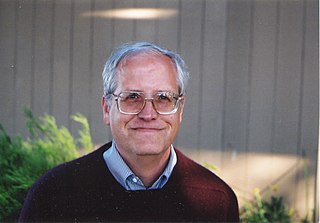
In mathematics and physics, Laplace's equation is a second-order partial differential equation named after Pierre-Simon Laplace, who first studied its properties. This is often written as

In mathematics, a partial differential equation (PDE) is an equation which imposes relations between the various partial derivatives of a multivariable function.

In mathematics, mathematical physics and the theory of stochastic processes, a harmonic function is a twice continuously differentiable function f : U → R, where U is an open subset of Rn, that satisfies Laplace's equation, that is,
In mathematics, the Dirichletboundary condition is a type of boundary condition, named after Peter Gustav Lejeune Dirichlet (1805–1859). When imposed on an ordinary or a partial differential equation, it specifies the values that a solution needs to take along the boundary of the domain.

In mathematics, in the field of differential equations, a boundary value problem is a differential equation together with a set of additional constraints, called the boundary conditions. A solution to a boundary value problem is a solution to the differential equation which also satisfies the boundary conditions.
In mathematics, a Dirichlet problem is the problem of finding a function which solves a specified partial differential equation (PDE) in the interior of a given region that takes prescribed values on the boundary of the region.
In mathematics, the Neumannboundary condition is a type of boundary condition, named after Carl Neumann. When imposed on an ordinary or a partial differential equation, the condition specifies the values of the derivative applied at the boundary of the domain.
In mathematics, the Newtonian potential or Newton potential is an operator in vector calculus that acts as the inverse to the negative Laplacian, on functions that are smooth and decay rapidly enough at infinity. As such, it is a fundamental object of study in potential theory. In its general nature, it is a singular integral operator, defined by convolution with a function having a mathematical singularity at the origin, the Newtonian kernel Γ which is the fundamental solution of the Laplace equation. It is named for Isaac Newton, who first discovered it and proved that it was a harmonic function in the special case of three variables, where it served as the fundamental gravitational potential in Newton's law of universal gravitation. In modern potential theory, the Newtonian potential is instead thought of as an electrostatic potential.

Pierre-Louis Lions is a French mathematician. He is known for a number of contributions to the fields of partial differential equations and the calculus of variations. He was a recipient of the 1994 Fields Medal and the 1991 Prize of the Philip Morris tobacco and cigarette company.
In mathematics, the viscosity solution concept was introduced in the early 1980s by Pierre-Louis Lions and Michael G. Crandall as a generalization of the classical concept of what is meant by a 'solution' to a partial differential equation (PDE). It has been found that the viscosity solution is the natural solution concept to use in many applications of PDE's, including for example first order equations arising in dynamic programming, differential games or front evolution problems, as well as second-order equations such as the ones arising in stochastic optimal control or stochastic differential games.
In mathematics, integrability is a property of certain dynamical systems. While there are several distinct formal definitions, informally speaking, an integrable system is a dynamical system with sufficiently many conserved quantities, or first integrals, such that its behaviour has far fewer degrees of freedom than the dimensionality of its phase space; that is, its evolution is restricted to a submanifold within its phase space.

Lawrence Craig Evans is an American mathematician and Professor of Mathematics at the University of California, Berkeley. He received his Ph.D. with thesis advisor Michael G. Crandall at the University of California, Los Angeles in 1975.
In numerical mathematics, relaxation methods are iterative methods for solving systems of equations, including nonlinear systems.
In mathematics, the Dirichlet energy is a measure of how variable a function is. More abstractly, it is a quadratic functional on the Sobolev space H1. The Dirichlet energy is intimately connected to Laplace's equation and is named after the German mathematician Peter Gustav Lejeune Dirichlet.
In mathematics, a Poincaré–Steklov operator maps the values of one boundary condition of the solution of an elliptic partial differential equation in a domain to the values of another boundary condition. Usually, either of the boundary conditions determines the solution. Thus, a Poincaré–Steklov operator encapsulates the boundary response of the system modelled by the partial differential equation. When the partial differential equation is discretized, for example by finite elements or finite differences, the discretization of the Poincaré–Steklov operator is the Schur complement obtained by eliminating all degrees of freedom inside the domain.
In numerical mathematics, the boundary knot method (BKM) is proposed as an alternative boundary-type meshfree distance function collocation scheme.
Joel Spruck is a mathematician, J. J. Sylvester Professor of Mathematics at Johns Hopkins University, whose research concerns geometric analysis and elliptic partial differential equations. He obtained his PhD from Stanford University with the supervision of Robert S. Finn in 1971.